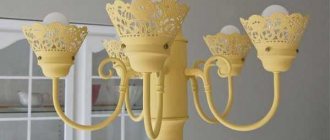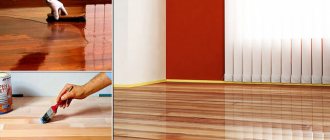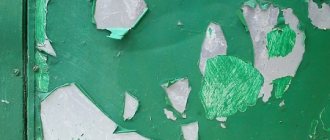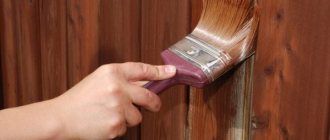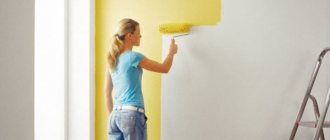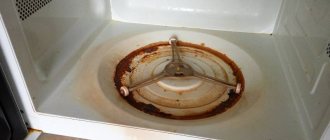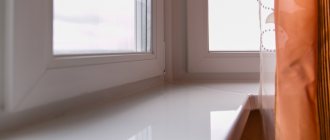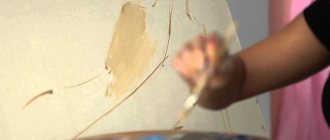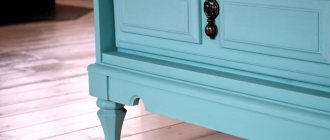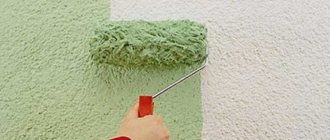Tools and materials
So how do you update your coverage? To perform this type of work at home you will need the following:
- putty;
- primer;
- sandpaper of different grain sizes;
- sander;
- roller;
- spatulas of different widths;
- brushes;
- vacuum cleaner;
- solvent;
- masking tape;
- personal protective equipment: respirators, gloves;
- varnish, paint for laminate.
On video: the nuances of laminate processing.
Professional tool
In addition to the previously mentioned tools, several more devices may be needed for laying laminate flooring. Let's take a look at their purpose and main characteristics in more detail.
Clamp
This device is convenient for laying outer laminated panels that are fixed around the perimeter of the living space. The bracket allows you to evenly fasten the part along its entire length; it is made in the form of a curved plate with a thickness of at least 5 millimeters, reminiscent of a mount. The ends of the plate have bends, one of them is made at a right angle. The ends of the clamp are of different widths, one larger than the other.
Important! To tamp the panels it is necessary to apply a certain force. In some cases, this may require a hammer. The clamp protects the flooring material from possible damage
During sealing work, the wide end of the tool is applied to the locking part of the panel, and the narrow part is struck with a hammer
The clamp protects the flooring material from possible damage. During sealing work, the wide end of the tool is applied to the locking part of the panel, and the narrow part is struck with a hammer.
Restrictive wedges
This tool is used to provide an expansion gap of 8-12 millimeters between the floor covering and the building envelope. Wedges are installed around the perimeter of the room. Such a gap is necessary to compensate for the possible expansion of the flooring material, which occurs during sudden temperature changes or changes in humidity in the room.
Important! Skirting boards must be attached to the walls, which will allow the panels to move unhindered during expansion. After installation work, the wedges are removed.
Tamping block
A special tool, a hammer, is used for finishing and compacting each of the installed panels. With its help, you can join the boards together well and efficiently, which allows you to get a monolithic floor covering. When using a tamping block, the possibility of damage to the lock joints is minimized.
The hammer is made from durable wood or plastic
When purchasing this part, you need to pay special attention to its quality. The product in question must have a straight edge and weigh at least 1.5 kilograms. If the surface of the punch is deformed during the work, it must be replaced with a new product.
If during the work the surface of the puncher is deformed, then it must be replaced with a new product.
Advice! If you don’t have a tamping block, you can use a rubber hammer or use a regular tool and an even piece from the plank to ensure a high-quality connection of the lamellas.
Feather drills
Such devices are necessary for drilling holes in laminate panels in places where utility lines are laid. It should be noted that the holes are made several millimeters larger than the diameter of the pipes.
When laying large areas of laminate flooring, you may need professional tools:
- The slab cutting machine with dust removal equipment allows you to carry out work with maximum precision without effort. Cutting is carried out strictly at right angles.
- The automatic square allows you to calculate the angle. The scale of such devices starts at 30 degrees.
- Special templates for marking work.
Features of laminate as a floor covering
Laminate is a coating that is quite in demand on the finishing materials market, as it has a lot of advantages, including low price and beauty. It is also valued for a certain level of durability, ease of installation, variety of colors and the ability to choose a coating to suit every taste and color.
Laminate has many advantages
On a note! Thanks to its wide range of colors, laminate can imitate such expensive types of flooring as wood or stone. It can also have a single color or be decorated to match tiles, etc. Thanks to this, it is not difficult to fit it into the overall style of any interior.
Basic colors and textures of modern laminate
But this material also has a certain range of disadvantages. These include the tendency for scratches to appear on the surface of the lamellas as a result of intense mechanical stress, as well as the fear of high levels of humidity. And if, due to humidity, the question “Can laminate flooring be painted?” does not occur, then scratches, as well as a banal desire to change the color and renew the coating can provoke its appearance.
Laminate flooring
Before we talk directly about the answer to the question, it is worth remembering what this material is. First of all, it is important to know and understand that this coating is multilayer. The table below shows the main layers of laminated boards.
Laminate structure
Table. Laminate structure.
| Coating layer | Characteristic |
| Substrate | Its functions are to protect the board from below from moisture, as well as to give the floor a certain degree of sound and heat insulation. |
| The basis | The thickest and most durable layer, usually made of fiberboard or other material, but most often - from fiberboard. It is this that gives the coating strength and rigidity. But fiberboard is afraid of moisture, and therefore it must be protected from its effects. When liquid gets on the fiberboard, the material swells. Also, it is on this part of the lamella that there are locking locks for connecting individual laminate planks into a single covering in the room. |
| Decorative layer | This is the very layer that gives the laminate a certain color. This is usually the paper on which the image is printed. It is fixed to the fiberboard and covered with an additional protective layer on top. |
| Protective layer | This is a laminated layer, very thin, but durable and capable of protecting the laminated floor from water and a number of mechanical influences. Contains melamine resins. The coating is applied during the production of the material, impregnates the paper layer and, when hardened, becomes durable and transparent. |
GOST 32304-2013. Laminate flooring based on dry-processed fiberboards. Specifications . Downloadable file (click the link to open the PDF in a new window).
GOST 32304-2013
SP 29.13330.2011. Floors (Updated edition of SNiP 2.03.13-88) . Downloadable file (click the link to open the PDF in a new window).
SP 29.13330.2011
Laminate consists of several layers
On a note! The laminated layer of lamellas can be of different quality. Its strength indicators will depend directly on the amount of substance it contains - corundum. The more it is, the more reliable and stronger the top layer of lamellas will be.
What do the images on laminate packaging mean?
Laminate design and features of its operation
It is, in principle, possible to renew laminate flooring, but some nuances of the work must be observed.
Before you paint laminate flooring, you should take a closer look at what it is and how it differs structurally from parquet flooring.
Laminate floorboards, despite their similarity to parquet, have little in common with them. Their main difference is the material from which they are made.
If natural wood is used in the production of parquet boards and bars, then various composite materials are widely used in the production of laminated slats.
A classic laminated board consists of 4 layers, bonded together using polymer-based adhesives.
Features of operation
Due to this design of the laminate, if its top layer is damaged, all underlying layers are inevitably at risk, so damage to the protective surface should be considered not only as a decorative defect that worsens the appearance of laminate flooring.
Violation of the protective layer can cause “failure” of the entire floorboard - moisture and chemical components of cleaning agents penetrating into the base of the lamella will lead to its deformation, delamination or fungal damage.
To avoid deformation of the floorboards, you should limit yourself to dry cleaning with a vacuum cleaner or broom.
But it is quite clear that dry cleaning will not be able to rid the floor surface of stubborn dirt.
Moreover, a floorboard devoid of a polymer film tends to absorb dirt, and this makes cleaning it using a dry method almost impossible.
In this regard, painting the laminate is necessary not only to restore its decorative qualities, but also to protect it from adverse external influences.
As a preventive measure against premature failure of the laminated coating, it is recommended to choose it in accordance with its resistance class.
For example, in rooms with increased load on the floors (hallway, kitchen, living room) you should use a higher class laminate. The table shows the classes of laminate flooring, their recommended area of application and approximate service life.
Paint or change: in what cases does painting laminate flooring make sense?
Despite its strength and wear resistance, laminate sometimes loses its aesthetic function. This can happen if the coating is scratched, faded in the sun, or stained with substances that cannot be washed off. If the appearance of several tiles has changed, it is not practical to replace or completely repair the floor.
You can resort to masking defects, that is, painting. It is also recommended to paint the laminate if cracks or dents appear on it: through them, dirt penetrates into the slab, which leads to its damage. A special coating will help protect the cracked slab.
Can laminate flooring be painted?
Agree - when undertaking a small cosmetic renovation, few people will want to change the entire floor covering at once. In such cases, the question arises: is it possible to paint laminate flooring?
Strictly speaking, if you follow all the rules and are careful, laminate flooring can be painted. The result can be quite beautiful. However, there are some nuances here. In order to understand them, let's consider the structure of the laminate.
Laminate is a multilayer material. The board usually consists of four layers glued together with polymer glue.
- The first layer is the base, which prevents the floor from deforming, making it rigid.
- The second layer is the base on which all locks and fastenings are held. Made from fiberboard
- The third layer is decorative. This is its entire purpose. By the way, laminate can imitate not only wood, but also tiles, stone, and even marble. For expensive types of laminate, this layer is made of veneer.
- The fourth layer is protective. These are polymer resins with a high degree of resistance to any impact. It is this layer that will absorb the impacts of hairpins, caustic detergents, spilled water and any other troubles that inevitably occur with the floor during operation.
It becomes obvious that it is due to damage to the protective layer that cracks, chips and abrasions appear on the laminate. It is important to consider that if you remove the top shiny layer from the laminate before applying paint, its protective properties will inevitably deteriorate. This means that no matter how good the homemade home coating is, it is inferior in its properties to the original factory coating. And yet, let’s answer the question “how to paint laminate flooring.” After all, if there are already abrasions on the laminate - places where the protective layer has been erased, then such boards need to either be replaced or repainted, since they can swell from moisture, detergents, or absorb any dirt.
Useful tips
How to paint laminate flooring? The flooring experiences significant loads when walking and from furniture. In addition, it is regularly subjected to wet cleaning. Therefore, it is recommended to choose paint in accordance with these conditions. For these purposes, it is best to use polyurethane or alkyd paints that have good performance characteristics.
Can laminate flooring be painted with wood varnish? The use of such material is completely acceptable. But when choosing, you must take into account that varnishes usually create a translucent coating. To create a glossy surface, a special polyurethane or epoxy tinted varnish is used.
For painting, it is better to use polymers combined with melamine resin. The fact is that the laminate undergoes a special factory finishing during the manufacturing process, as a result of which a moisture-resistant coating is formed. In order to create a more durable coating, it is necessary to make the thickness of the coating as large as possible. Also, using a thick layer of coating will eliminate the problem of floor squeaking.
What is the complexity of the process
A special film is glued on top of each laminated board, which performs certain functions, in particular, it protects the material from moisture. At the same time, it does not allow the paint to reliably “stick” to the surface, i.e. no adhesion.
The very smooth top of the lamellas cannot securely hold regular enamel. As a result, no matter how beautifully you paint the floor, it will peel off within a month. The paint will remain only in the recesses that imitate the texture of wood, and in the gaps between the boards.
What does laminate consist of?
Without an understanding of the structure of the material, it will be difficult to move forward to solve the problem. Therefore, this is what we will do now.
A laminated board consists of several layers, each responsible for a specific function:
- The top
protective coating is responsible for the product’s ability to withstand mechanical stress. Due to this layer, the floor remains intact for a long period, despite contact with rough shoes, pet claws and dirt.
It is made from boomoplast - paper that is impregnated with a mixture of corundum and melamine resin. Its strength depends on the content of the first component.
- The decorative one
is made of paper onto which the required image is applied. Thanks to the embossing process, the layer can imitate the texture of natural wood. - The load-bearing
layer is the thickest and densest. It is made from fiberboard or plastic. Equipped with a locking connection - groove or tenon. - The substrate for the laminate (bottom layer) is responsible for water and sound insulation.
It usually remains intact even when the coating wears out.
Whatever the price of the laminate, the protective and decorative layers begin to deteriorate first. Very rarely, some scratches may reach the supporting base. At the same time, it is the first layer that gives laminated boards their characteristic gloss. And it does not allow the paint to linger on the surface of the product.
That's why:
- To successfully paint laminate flooring, you need to matt the protective layer to increase its adhesion.
- Chips and scratches can be smoothed out by filling them with putty to a depth of 2-3 mm, i.e. the first two layers.
Technology
The instructions for preparing them for painting depend on the degree of wear of the lamellas. The process is complex, so it is better to split it into several stages.
Preparation
- Clean the floor surface from dirt.
- Use coarse sandpaper to remove damaged flooring.
- Remove dust with a vacuum cleaner.
- on wood and wait until it dries. After this, cover the damaged area again with putty until it is level with the surface.
- Take medium-grain sandpaper glued to the foam rubber, and after the putty has dried, level the putty surface.
- Clean the floor with a vacuum cleaner.
- Prepare fine-grit sandpaper for finishing work and carefully matte each lamella.
- Vacuum the floor, soak a soft, lint-free cloth in a solvent such as white spirit, and wipe the surface of the slats.
Choose ordinary enamel for painting, for example, PF 226 or PF 115. Dilute the paint to a liquid state also with white spirit. Keep in mind that you will have to paint in several layers, so the material must not only be liquid, but also thoroughly mixed.
Elimination of cracks and deep scratches
Old laminate flooring is more susceptible to damage because the protective coating layer becomes thinner as a result of use. Then quite deep scratches appear on the floor surface. However, even in this situation, it is possible to restore the laminate using the following means:
- Putty for laminate;
- Spatula for filling cracks.
Special putties for restoration are sold in the form of powders and diluted with water according to the instructions. Apply the product exclusively to the scratch and only with a spatula. The putty should not be allowed to “crawl out” beyond the damage, since cleaning it is quite problematic.
Painting technology
If you decide to paint the type of flooring presented, then you must adhere to each stage of the process and do it efficiently. So, the technology for painting laminate flooring consists of following the following rules and processes:
All contaminants must be thoroughly removed from the surface of the laminate: dust, dirt, various stains; After preparation is completed, you need to sand the coating
Please note that you should not choose large sandpaper, as it will leave a large number of scratches that you will not be able to get rid of. After the coating is completely sanded, you need to remove the formed shavings from the material; Large scratches or other defects that have formed must be eliminated using putty.
If the scratches are very deep, then it is worth filling the hole with putty material and removing the remains using a regular spatula. Once all the scratches have been removed and the putty has dried, you need to apply a second coat. It will help make the floor better and more durable; The putty must be processed so that the surface does not have defects. In this case, you need to use fine sandpaper. Once the work at this stage is completed, you need to remove the debris. The best way to do this is with a vacuum cleaner; Requires fine-grained sandpaper. This will help create a matte finish. It is imperative to process each piece of laminate, separately; The laminate should be vacuumed and treated with a damp cloth using a solvent. This will help remove various greasy stains; You need to attach masking tape to the walls so as not to spoil the paint; You can start painting.
Rules for using laminate flooring that will prolong its service life
- Wash the floor with plenty of water.
- Use abrasive detergents.
- Use sharp objects to remove dirt.
- Use moisture-retaining mats on the surface of the laminate.
- Lay carpets on the surface of the laminate, under which the heated floor system is installed.
Text: Natalia Stepanova
The article was published in the magazine “Professional Advice” No. 9 (2019). You can subscribe to the print version of the publication.
How to paint laminate flooring?
So, all the pros and cons have been weighed and a clear decision has been made - to paint. The question immediately arises: how to paint laminate flooring? Laminate for painting has not yet been invented, so this is not an entirely ordinary task. In fact, painting laminate flooring is not that difficult.
How to paint laminate flooring?
As we figured out earlier, a laminate without a protective layer is especially afraid of any moisture. Therefore, we immediately refuse water-based paints. They can be absorbed into the laminate, it will swell and the floor covering can only be thrown away. Use alkyd or polyurethane dyes.
Experts do not recommend covering laminate flooring with varnish. Since under the influence of the weight of people walking on the laminate, the boards “walk” slightly, the varnish will very soon crack at the fastening points and begin to peel off. Washing the floor will only speed up this process.
Stages of painting laminate flooring.
- Preparing the room - all furniture and textiles are removed from it. Then the floors are washed and cleared of debris and dust.
- Sanding - depends on the specific type of laminate. Scratches and abrasions will have to be sanded down in any case. Whether to sand the entire floor depends on the type of laminate. Keep in mind that paint adheres better to a sanded rough surface. The coloring composition simply cannot penetrate and be absorbed into the upper protective layer. However, by removing this factory layer with sandpaper, you are voluntarily reducing the durability of the laminate.
- Puttying and sanding damaged areas. Several coats of putty may be needed before the damage is completely filled. Apply a new layer only after the previous one has dried.
- To increase the adhesion of the laminate, you can coat it with an oil base.
- You need to apply paint from the corner farthest from the door so that you don’t end up in a difficult situation at the end of the work. The paint is applied with a brush or roller, distributed in as thin a layer as possible. For the best look, the stroke should be long and along the floorboard.
- Applying varnish is the final stage. Use alkyd or polyurethane varnish. Proceed to the final stage only after the paint has completely dried.
As you can see, if you want, painting laminate flooring is quite possible! The main thing is to understand the basic principles of work, to act slowly and carefully.
As you know, laminate is a multilayer structure. The top layer consists of transparent resin and performs protective functions. But, despite its high strength, the protective layer wears out over time. You can restore the floor covering if you paint the laminate.
The laminate is painted with varnish, but you can use a different, darker color. This painting will give the laminate a fresh glossy shine and hide minor defects in the form of scratches and abrasions. Let's take a closer look at this issue.
Technology of applying varnish to laminate
The composition is applied to exclusively dry lamellas with a paint roller or a wide soft brush
. Preliminarily cover the lower perimeter of walls and other vertical structures with protective tape. It is also important to ensure high-quality ventilation of the room and to work using personal protective equipment.
The nuances of creating a varnish coating on a laminate:
- Since the composition dries quickly, you need to work carefully and at a fast pace. It is worth considering that there will not be time to correct errors;
- work with a roller in a cross-shaped motion. Apply the composition across the line of laying the flooring, level it in the direction of the boards;
- when painting, M-shaped movements with a roller are excluded, this is fraught with shadow-like phenomena on the plane and a decrease in the decorative and operational potential of the varnish finish;
- process the surface, creating a thin layer of varnish, achieving uniform distribution of the substance;
- paint the laminate with 3-5 layers of varnish, maintaining a pause between applications for drying.
Important! Finally, the surface is finished using a special polish, taking into account that the varnish surface of the laminate is subject to minor damage.
Source: https://gidpokraske.ru/sovety-ot-gida/kak-pokryt-laminat-lakom-kakoj-vybrat-lak-podgotovka-i-tehnologiya.html
Opinions against laminate restoration
There are conflicting opinions regarding whether laminate flooring can be varnished.
- The first is related to the structure of the floor covering. Laminate is made by combining individual materials: balancer, supporting panel, kraft paper, decorative strip, protection. The last layer of finishing material is film. It has a smooth texture, and applying additional coating to it may end in failure. Since the varnish is not absorbed into the surface of the laminate, it does not guarantee strong adhesion to it. The result is that the varnish may soon crack and come off the floor.
- The second judgment concerns the laminate installation technique itself. It is not fixed to the floor in any way; under conditions of changes in humidity and temperature, it is unstable and can move. Such fluctuations will also affect the varnish coating.
- When walking on the floor, the slats sag over time. This may also negatively impact the additional coverage.
How to put it yourself?
All work on laying laminate on walls can be done independently. You don't need to be a super master to do this. You can sheathe any one with high quality with your own hands, be it straight or crooked.
Very often people ask us - how to nail it vertically? So - there is no need to nail it anywhere; even if you imagine that the heads of the nails will be driven into the grooves of the lamellas, then the next board will not fit tightly.
Remember the main thing: before you start fixing it yourself, let it rest after purchase, it must be saturated with the atmosphere of the room and accept the ambient temperature.
Do-it-yourself fastening can be divided into two main options - horizontally and vertically.
Description and characteristics of tools
Many users hire professional builders to install laminate flooring in their apartments, but such operations can be done with your own hands. First, you need to calculate the building material and purchase it. After this, they lay out the panels on the floor and prepare the necessary tools.
From measuring instruments we will need:
- A construction tape is used to measure the length and width of a room, determine the length of finishing materials before trimming;
- A medium-sized metal or wooden square of at least 25 centimeters is used to determine precise right angles on parts;
- The protractor is used to determine angles and is used to mark laminate panels when laying in complex ways, for example, “diagonally” or “herringbone”.
- A simple pencil or black marker is needed to draw marking lines on parts before cutting.
Next, let's get acquainted with the set of tools for carrying out basic work:
- A stationery knife with sharp, replaceable blades will be needed to cut the laminate backing. This tool is easy to use, very sharp and effective. When the blade becomes dull, it is enough to break it off or insert a new cutting part into the holder.
- A jigsaw is considered one of the most important tools; it is used for cutting laminated panels along pre-applied marking lines. To carry out installation work, it is recommended to purchase an inexpensive device with a minimum power of about 500 watts. You should not buy the cheapest models of power tools; they have limited power and can quickly break under heavy load. In addition to the jigsaw, you need to purchase an additional set of files, because the blade may break. The tool is used not only for cutting sheets in a straight line, it is convenient for making holes in planks in places where utility lines pass.
- A fine-toothed hacksaw can be used instead of a jigsaw.
- Many users do not know how to line laminated panels during installation. Locking connections have minimal gaps; when joining them manually, the user may encounter certain difficulties. For high-quality connection of products, a small rubber hammer is used. If such a tool is not at hand to adjust the panels, you can use a regular metal hammer, but in this case it is necessary to use an additional wooden beam so as not to damage the joints of the elements.
We learned what basic tools are needed to carry out work on laying laminated panels. In addition, you can use additional devices to simplify installation.
Application technology
The work is performed as follows:
- the floor is thoroughly cleaned with a vacuum cleaner;
- if there are defects on the coating, they are masked using special colored pastes or wax;
- apply the varnish with a roller or brush, evenly distributing the composition over the surface;
- You need to apply it in three or four layers, waiting for the previous layer to dry.
Some home craftsmen believe that before applying the first coat of varnish, it is necessary to sand the laminate in order to improve adhesion. Experts categorically do not recommend doing this, since sanding will render the coating unusable and will need to be replaced.
Laminate varnish can be used for restoration or protection purposes. Practical experience shows that the latter option is more profitable, especially if there is a high risk of damage to the laminate in the house. For example, if there are pets in the house that can damage the laminate.
Laminate varnish coating technique
The method of applying additional coating is quite simple, you just need to strictly follow the instructions and be careful. It is necessary to prepare all materials and tools:
- paste for covering irregularities;
- wide brush or roller;
- means for protecting the respiratory tract from chemicals.
Before you start work, you need to clean the floor surface from all kinds of dirt, unevenness and allow it to dry well. Under no circumstances should you clean the laminate with tools that are used for processing wooden products (sandpaper, sandpaper, etc.), as this can completely ruin it. It is better to cover all roughness with a special paste. You can buy it in the same store as the varnish.
How to care for painted laminate flooring
Having dealt with the question of what can be used to paint laminate flooring, it is worth mentioning the subsequent care of the coating. Floors will last longer if you care for them properly. Regular cleaning of homemade surfaces is a top priority. If we are talking about wet cleaning, then the floors need to be wiped dry. The humidity in the room must be maintained adequate to the performance characteristics of the laminate strips. The paint layer can be easily damaged by sharp or heavy objects (when moving them). Therefore, when planning reshuffles, you need to prepare in advance for updating the coverage. Carpets with dust and sand particles, heavy furniture, high-heeled shoes - all this can damage the painted surface.
Cleaning laminate floors
Is there any point in painting?
Knowing the structure of laminate, you can immediately understand that painting it will not be so easy. The reason is the same protective laminated layer, which simply will not provide the required level of adhesion, and the paint will not adhere, and if it does, it will quickly peel off. So first you should think carefully about the feasibility of carrying out such work.
To paint laminate flooring, you will have to carry out a number of preparatory works that are labor intensive. Also, during their implementation, a lot of dust and debris will appear. The main aspect of painting laminate flooring is removing or stripping away all of the glossy layer. Otherwise, painting it is simply useless.
And in general, painted laminate will certainly lose its attractive appearance. It will look cheap and unpresentable. And this is also a big disadvantage of painting this type of coating.
Is painting laminate flooring not a solution?
On a note!
It is also important to remember that laminate is afraid of moisture. And the usual painting of the surface with a water-based paint composition can harm the coating.
The opinion of experts is that painting laminate flooring is a pointless and labor-intensive task. It makes sense to just put on a new coating and not worry about it. Moreover, laminate itself is not an expensive material, and previously laid, if it is in good condition, can be used to finish floors in other rooms or even sold.
Economic justification for painting work
When choosing this method of updating the floor covering, it is worth considering the cost of the work. As mentioned above, to carry out this type of work it is necessary to purchase a considerable amount of building materials and have a lot of free time. By the way, according to most experts, purchasing a new laminate will be much cheaper. It also takes less time to install new flooring.
Expert advice (2 videos)
Materials for processing laminate (18 photos)
Conclusion
If your laminate flooring is damaged, do not rush to replace it, as there is an easier way to restore it. To do this, you can simply paint it with special floor paint.
Laminate is a floor covering consisting of tightly pressed and bonded wood fiber material. This finishing resource is quite dense in structure and wear-resistant. But with intensive use or improper care, it may require restoration work. This can be done by applying varnish to it. The admissibility of using such measures raises a lot of doubts among many, so you should figure out whether it is possible to varnish the laminate and how best to do it.
Laminate restoration
Despite the resistance of this material to mechanical loads, during operation scratches and abrasions appear on it, which are difficult to remove. The most effective option for restoring an old surface in this case is painting.
As for how to update laminate flooring using stain and finishing varnish, this is impossible. This is due to the fact that before painting the coating should be restored with putties, which will remain visible under the varnish layer. Read whether laminate flooring can be varnished, and draw your own conclusions.
The main problem that arises in the process of painting such a surface is the lack of adhesion. On the smooth surface of panels, ordinary enamel does not adhere well. Because of this, the paint on the floor may peel off within a couple of months. It will remain only in the recesses and joints between adjacent panels.
Expert opinion on the topic of painting laminate flooring
To understand whether laminate flooring can be painted a different color, you need to remember what the coating consists of. The very name “laminate” reminds us that this material is covered with a laminating airtight film, the so-called “overlay” (from the English “overlay” - coating). If you apply paint directly over it, there will be no adhesion and the color will quickly rub off. And if you remove this film for better adhesion, the laminate will lose its waterproof properties. In this case, you will have to apply a varnish with a lamination effect over the paint.
Therefore, you can paint laminate flooring, but it’s better not to. A painted floor will not look as aesthetically pleasing and will not last very long. It is better to renew the coating completely: the price of laminate is affordable, and even a beginner can install it.
Safety precautions: how to protect yourself and indoor surfaces?
Carrying out repair work with coloring compounds at home requires compliance with safety measures. Vapors from varnishes, paints, stains, primers and other materials are poisonous and can cause poisoning of the body. To protect yourself from them, you need to wear a mask over your mouth and nose, and glasses over your eyes.
For minor repairs to small areas of laminate flooring, furniture may remain in place or may need to be moved. Masking tape will help protect its legs or lower part from paint, varnish or stain.
The sequence of repair and finishing work in the room
dated February 26, 2015
If you are planning to make serious repairs in a separate room or an apartment as a whole, you should draw up a complete work plan and cost estimate, including items such as dismantling old equipment (batteries, window sills, lamps, switches). If you need to replace windows and doors, include cleaning and removal of construction waste in the list of works. In most cases, this is a significant expense item, especially in an apartment building within the city.
It is very important to determine the actual scope of work and correlate it with your financial capabilities. It is extremely undesirable to make adjustments after the start of repair and finishing work - for example, after painting the walls, you want to lay parquet instead of laminate or stick wallpaper instead of decorative plaster. Therefore, all design decisions must be made before the actual repair work begins. Remodeling is expensive, time consuming and sometimes impossible.
Eliminating cracks
It is also possible to restore laminate flooring when gaps form between the lamellas, but only if they are insignificant. After repair, they are usually not visible, but to eliminate the defect you need to use a special repair kit, or a composition made in a “handicraft” way.
Homemade composition includes:
- Crushed chalk;
- Construction paint matching the color of the coating;
- Liquid glass;
- Wood sawdust.
To ensure a high-quality putty, before connecting all the components, dilute liquid glass with a small amount of water. The finished composition should be quite thick. Only after this are all the cracks covered with a spatula, and then carefully cleaned with sandpaper. Then the restored floor must be polished using a special solution for caring for wood flooring.
Work technology
Coating laminate flooring with varnish does not cause technological difficulties even for a beginner. However, several nuances must be observed, for example, proper surface preparation.
Preparatory stage
Work on preparing the laminated coating for painting consists of the following work:
- The surface of the slats must be thoroughly cleaned of debris and dust.
- The floor covering must be completely dry.
Cycling or surface treatment with sandpaper should not be used as preparation. To hide large defects (for example, chips or cracks), you can use colored putty or finishing putty of a suitable color.
Applying varnish
In order for independent painting of a new or restored laminate to be successful, and the protective coating to last for the maximum period, you must adhere to these simple recommendations:
- To apply the varnish, use a roller or wide brush.
- Varnishing is done in several layers (usually 3–4). Therefore, it is necessary to calculate the amount of material.
It should also be remembered that such painting is significantly inferior to the factory treatment of laminate. Therefore, the protective coating needs to be renewed once or twice a year, depending on the intensity of use.
In conclusion, it should be noted that none of the manufacturers of laminate flooring will give a clear answer about the benefits or harms of painting laminate flooring with varnish. All work is carried out by folk craftsmen at their own discretion
The only thing worth paying attention to is the compatibility of materials and choosing the right varnish so that the color of the flooring does not become too dark
Perhaps today laminate is considered the most popular flooring. During renovation work, more and more of our compatriots prefer it, and all thanks to the availability and wide range of shades and colors of this finishing material.
It is easy to install with your own hands. But few people know whether it is possible to paint laminate flooring when repairing the coating!
Another advantage of this coating is its fairly high strength and reliability, which allows the laminate to be used in any room, including where people are most often present. These can be offices and apartments, country houses, cottages and dachas.
How to care for painted surfaces?
Home painting makes the coating more susceptible to any mechanical stress, so you need to treat it more carefully. It is prohibited to walk on painted laminate flooring in stiletto heels. It is not advisable to place heavy furniture on it.
Many experts assure that a floor renewed by painting must be washed extremely carefully, wiping with a slightly damp cloth and then wiping dry. However, housewives note that after proper repairs, laminate flooring becomes not as capricious as before. They wash it more boldly using liquid household chemicals.
I note that a varnished floor will last another 3-4 years. Then it will have to be updated. However, this will still be a simpler and cheaper repair than completely replacing the laminate. For completeness, I suggest you watch the following video.
Other laminate cutting tools and their features
In addition to a jigsaw, there are other ways to trim laminate flooring. Having one of them in stock, you don’t have to buy a jigsaw, but use what you have. You can get a neat cut without damaging the laminate board using a circular saw, a special cutter and a hacksaw. We will tell you how to do this below.
Grinder for cutting laminate
Cutter
This is a professional tool that is quite expensive and is used by craftsmen whose work involves large volumes of orders for laying laminate flooring. Such a tool is a supporting structure on which a very sharp blade is attached. The board is cut in one step, like a guillotine.
Laminate cutter
Using such a device, trimming can be carried out in different directions - along or across the lamella, while the length of the cutting element has a decisive influence on the quality of the cut along the lamella.
Operating principle of the cutter
Table 2. Operating principle of the device
| Illustration | Description |
| The mechanism handle must be pulled back. | |
| The lamella with the applied markings is placed on the supporting structure of the mechanism. The cutting line should be located to the right of the knife. | |
| The knife handle is lowered smoothly and, pressing, the required fragment is cut off. |
There are no marks left from the cut on the front side of the lamella, and on the back side, if necessary, the torn edges are sanded with sandpaper.
Hacksaw for metal
Unlike a cutter, a hacksaw is the cheapest and most accessible tool for cutting laminate flooring. Every homeowner has a hacksaw and can use it when it is necessary to cut a small amount of laminate. The simplest hacksaw costs from 200 rubles.
The use of a hacksaw is justified when there is no electricity at the site
When cutting laminate flooring using this tool, you must adhere to the following recommendations:
- The tool must be ready for use - the metal blade is securely fixed and its tension is checked.
- On the surface of the lamella, a line is drawn along which the cut will be made.
- The lamella is fixed on a rigid support and the panel is sawn with smooth movements.
The process of sawing laminate boards
The disadvantage of such a tool when performing this particular type of work is the labor-intensive process and the need for skill. Laminate is a dense material, so you can practice on a piece of board or plywood that is similar in structure.
A circular saw
The high cost and availability of professional skills to work with this tool put it on par with a cutter. The result when cutting laminate flooring with a circular saw is very high quality.
A circular saw
The tools are divided into professional and household. The first type has additional elements: a stand, a support structure and a clamp for securely fixing the panel.
Professional tool
It is clear that the cost of household models is lower than that of professional ones. But it is also recommended to choose them starting from the middle price category - a cheap tool is not practical and will not last long.
Table 3. Average cost for circular saws
| Model name | Power, W | Disc diameter, mm | Weight, kg | Cost as of July 2021, rubles |
| Bort BHK-185N | 1200 | 185 | 3.5 | 2 600 |
| Makita HS7601 | 1200 | 190 | 4 | 7 500 |
| Hammer CRP 1800 D | 1800 | 210 | 6 | 5 300 |
| MILITARY DS1250 | 1250 | 185 | 3.4 | 2 900 |
| Hitachi C6SS | 1050 | 165 | 3.2 | 3 900 |
The correct choice of disk plays an important role. Its size should be from 16 to 20 cm with a blade thickness of no more than 0.2 cm. The disc should have 48 teeth.
The peculiarity of cutting with a circular household saw is that it must be held level, smoothly pushing forward without sudden jerks.
Cutting process - the lamella must be securely fixed
Laminate is different in composition from wood, so it has its own characteristics when working with it.
Installation
According to the technology for performing the work, installing a plastic (PVC) laminate is no different from laying a regular one. Interlocking connections allow you to create a durable monolithic canvas without cracks. Before starting work, we recommend that you read the coating instructions in full and strictly follow the manufacturer’s recommendations. This will ensure the guaranteed service life of the floor.
Preparing the base
The base is leveled so that the difference does not exceed 2 mm per 1 linear meter. Depending on its condition, leveling is carried out by pouring a cement-sand screed; small defects are eliminated by sealing them with a leveling mixture. After this, remove debris and dust with an industrial or household vacuum cleaner.
Wooden floors are leveled with chipboard or OSB slabs, the joints of the slabs are puttied and cleaned.
Tools
Installing plastic is no different from installing conventional laminate. The work will require the same tools:
- level 2 m long;
- measuring tape or metal ruler 1 m long;
- pencil or marker;
- mallet;
- metal clamp;
- a flat wooden block measuring 2x4x50–100 cm for padding the laminate;
- limiter wedges 1.0–1.5 cm thick to fix the gap between the walls and the covering (you can
- purchase ready-made ones or use pieces of wooden planks of this thickness);
- jigsaw with metal file;
- masking tape.
Selection of paints and varnishes
The result of painting a laminated coating is influenced by the correct selection of the composition for application. When released, the lamellas are covered with an airtight durable film. This is a smooth layer on the surface that is difficult to adhere to paint compounds. If you do not artificially increase the roughness, the paint will quickly come off the laminate surface.
Partial matting of the laminate will increase the ability to absorb moisture, so a varnish with a protective effect is applied over the paint. The paint is chosen to obtain a durable layer on the surface that has high adhesion to the laminate and will not roll off during operation or immediately after drying.
The plasticity of the resulting film is important, because laminate is referred to as a free covering that flexes and moves under load.
Alkyd paints
For production, a base with a film-forming effect, highly dispersed pigments, plasticizers, driers, solvents, and hardeners are used.
Depending on the varnish used, alkyd paints are divided into types:
- glyphthalic;
- pentaphthalic.
The first takes a long time to dry, a hard film forms within a day at temperatures above +20°C. The setting time is reduced by uniform heating to 60–85°C or by the introduction of hardeners. After gaining strength (after about two weeks), the coating is difficult to scratch and dissolve. The surface does not require polishing. You can dilute the paint with a solvent, but not more than 30%.
Pentaphthalic compositions are common for interior decoration; they are produced on the basis of alkyd varnishes. The category includes the previously popular PF-115 and PF-226. For painting laminate, it is better to use the first brand, because... it is characterized by increased strength. Alkyd paints are applied to the primed surface, diluted with solvent, drying oil, and white spirit.
Polyurethane compounds
After applying polyurethane paint, the coating is ready for use after 2 days.
Produced on the basis of polycondensation resins, the result is a high-quality product for coating laminate flooring with high technical characteristics. Two-component mixtures are used, which are combined before application, and ready-to-use paints.
Properties of the resulting layer:
- large margin of strength and abrasion resistance;
- good adhesion to the prepared surface of the laminated board;
- safety for human health;
- elasticity and ability to bend slightly;
- resistance to aggressive air components and fats.
During production, the mixture is modified with copolymers based on polyurethane, while substances are dissolved with toluene, xylene, and pigments are introduced for color. The film on the surface of the layer appears under the influence of moisture from the atmosphere, so it is not recommended to use a hair dryer for drying. The coating is ready for use after two days, when it reaches 100% water resistance and strength.
Technique for applying coloring solution
To paint laminate flooring in a different color, you need to follow certain rules:
- As with varnishing, the floor must be clean. The only peculiarity is that when painting you need to clean the floor with hard sandpaper. Paint adheres better to rough surfaces. To remove large scratches, you can use wood putty. When dry, it is smoothed away from the tubercles with softer sandpaper.
- The prepared matte surface is cleaned again and treated with a special emulsion composition (primer). It acts as an adhesive link between the floor and the paint, and also levels the surface. The primer must dry well. Only after this can you start working with paints. The color and number of layers are determined independently.
- When renewing a laminate with polyurethane coloring mixtures, an important point is constant stirring, since due to the different densities of the solvent and the paint diluted with it, the coloring pigment will settle to the bottom.
- After application, you must wait until the enamel is completely dry, then you can apply the varnish.
Laminate varnishing: main advantages
Over time, any floor covering (even the most durable) is subject to wear and tear. Scratches from animal claws, the wheels of a computer chair, massive furniture constantly standing on the floor, the fall of sharp and cutting objects - all this can leave their mark on the laminate. As a result, roughness, chips, and abrasions appear on it, requiring masking. To remove them and return the flooring to its former freshness, you can apply varnish to the floor surface. Using an additional coating will cost much less than refinishing a worn-out floor.
For the purpose of additional strengthening and protection, the application of varnish enamel is also possible when laying a new, fresh laminate. This will allow the primary characteristics of the flooring to be preserved for a long time.
A pleasant appearance of the floor is an important point in home decoration. Laminate covered with a shiny film will give the interior a special appeal. But if enamel is needed only to decorate the home, then it is recommended to buy a ready-made finishing resource already varnished.
How to paint laminate?
If you do decide to update your flooring, follow the instructions to avoid common mistakes.
- Prepare the surface thoroughly: remove furniture from the room, sweep the floor and sand it. The rough surface gives better adhesion to the paint.
- Protect the walls with strips of masking tape.
- Clean the floor, preferably with a vacuum cleaner, and wait until it dries completely.
- Treat the surface with a primer.
- Paint can be applied to a dry, primed floor.
Please note: laminate flooring should not be coated with oil-based paints or water-based compounds. Instead, use alkyd enamels and polyurethane paints.
- Apply the required number of layers of paint and wait until dry. Then coat the floor with a polyurethane or alkyd-based varnish.
- When the varnish is dry, you can place furniture in the room.
Laminate coloring technology
Any person who has at least once held a brush, roller and spatula can carry out a complex of painting work. How to paint laminate flooring will be discussed in detail below.
The process of painting a laminating surface consists of the following technological processes:
1. Before starting painting work, clear the room of furniture, textiles, curtains, and also clean the floor from dust and debris. To do this, use a household vacuum cleaner, a soft cloth and clean water.
2. Next, begin sanding the damaged areas. To do this you will need coarse sanding paper. As a result, all minor scratches will be removed, and the damage will become smooth or completely level with the main surface of the floor. There is no need to sand the entire laminate floor. A vacuum cleaner is used to collect debris and dust generated during the grinding process. By the way, it is not recommended to use a washing vacuum cleaner for these purposes.
3. The next stage of floor preparation is to putty the areas previously treated with sandpaper. For these purposes, it is recommended to use acrylic putty intended for wood. It can be of different colors. Acrylic putty is applied with a rubber or steel spatula to the sanded areas twice. After complete drying, sanding is performed again. To do this, use fine-grained sandpaper.
Be sure to select an acrylic putty that is no darker than the existing floor covering. In this case, the painted laminate will look natural.
4. As a result of all the above operations, a smooth floor surface without scratches or damage is obtained. To make the repaired areas smoother, additional smoothing is done with felt or a piece of felt. If there are a large number of putty spots on the surface of the laminate, then it is better to use a sander with a special disc.
5. The next stage is priming the floor. To do this, use a primer for exterior use. Apply it to the surface with an ordinary paint roller twice. It should be remembered that each subsequent layer is applied after the previous one has completely dried.
6. After the preparatory procedures, they begin the main work, i.e. painting the surface of the laminate. Painting is done with a wide “flute” type paint brush. You can also use a foam paint roller to apply the paint composition. It is necessary to paint carefully with long strokes. In this case, you should try to roll out the paint as thoroughly as possible and in one direction.
To protect walls and door frames from paint stains, it is recommended to cover them with adhesive tape or masking tape.
7. After the paint and varnish materials have dried, perform a thorough visual inspection of the painted surface. If something needs to be corrected, then at this stage you can still eliminate the resulting defects. If the painted surface meets all the requirements, then you can proceed to the final painting of the floor surface. This will complete the painting of the laminate.
It is advisable to choose paint several shades darker than the existing coating.
How to paint a chamfer?
Laminate with bevel
Laminate with a chamfer is considered more practical, since such designs protect the slab from moisture getting inside. It allows you to create a floor covering that imitates the texture of parquet, which makes the floor more attractive.
When painting laminate flooring, the recesses in it should be treated separately. For this it is recommended to use special materials:
- Wax. Some craftsmen recommend that after painting the floor, walk along the chamfer with a wax candle, and then warm up the indentations with a hairdryer. However, this method will not renew grooves that have worn away.
- Wood putty. It is used to fill the seams in the floor during preparation for painting. It is also suitable for updating a chamfer on which the old protection has worn off. The advantage of this method is that paint and a layer of varnish are then applied on top, as a result the floor looks more natural.
- Two-component epoxy adhesive. It is poured into the seams and the surface is leveled with a spatula. Work is carried out before the floor is completely painted.
- Mastic. It is sold at any hardware store and comes in different colors. Mastic can be used to seal seams, hide scratches and other floor defects.
